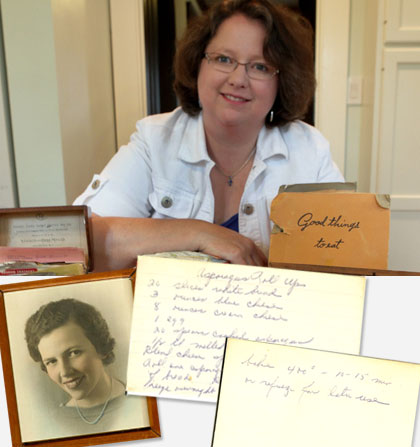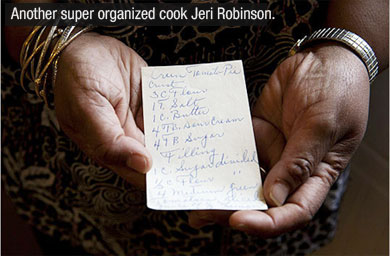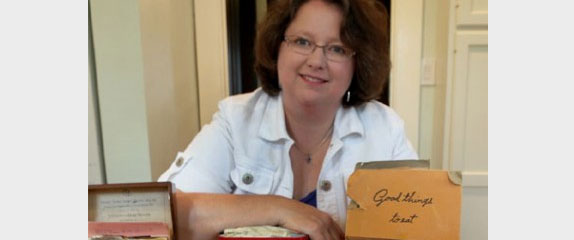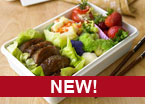Something old, something new
Barbara Rotger of Melrose amassed boxes, collections, and handwritten recipes
(photo Boston Globe Wendy Maeda)
MELROSE — Barbara Rotger rummages through personal notes that belong to other people. She’s a snoop of sorts. Rotger collects handwritten cookbooks and boxes brimming with recipes that she finds on eBay and at yard sales. “The poorer the condition,’’ she says, “the more interesting the material.’’
Rotger began with a recipe box she inherited from her grandmother Marion Griswold Doane, who lived in Essex, Conn. It holds the food memories of Rotger’s childhood. All recipe collections and their handwritten or typed index cards are windows into our cultural past, transmitting family histories and evoking memories (Nonna’s lasagna, Mom’s meat loaf). They take us back to molded gelatins, ladies’ lunches, canned-soup casseroles, fondue. Today collections of recipes — in boxes, notebooks, or a bundle held together with rubber bands — sit on kitchen counters, in plastic bags, on pantry shelves, or stuffed into drawers. Everyone is waiting for that month of Sundays when there’s time to get organized.

This weekend Rotger will receive a master’s degree in gastronomy from Boston University, where she turned her passion into scholarship. She wrote her thesis on “How to Read a Recipe Box: A Scholar’s Guide to Working With Personal Recipe Collections.’’ One box she acquired belonged to Edna Abens, a 1930s home cook from central Iowa, in which a recipe for brining a hog was written on the back of an envelope. “There were others for canning sandwich spreads and for pickling as well,’’ says Rotger. “Women didn’t leave records of their lives. This was their archive.’’
For cooks who are holding onto recipes they inherited or clipped years ago, there are all kinds of handmade craft options to buy or online software (see Page 19). Even though Rotger is drawn to the boxes and the oddments tucked into them, the romance of filling a recipe box is often trumped by the convenience of electronic media. “In all honesty, I save recipes on my computer and create files for the different categories,’’ she says.
Leslie Goldenberg of Holliston has become the consummate archivist. “Recipe organization is a little black cloud that hovers over me constantly,’’ she says. Wooden file boxes, built into her kitchen cabinets 18 years ago, hold hundreds of recipe cards. That has been joined by a higher tech system. “On my computer I have bookmarks and folders for specific categories that get subdivided.’’ Filing clippings and handwritten cards “is a multi-step process I tackle every few months. I tear out appealing recipes that I put into clear protective sleeves and into divided sections in various binders by category. I reach for my ‘Favorites/Family Heirlooms’ binder when I want a tried-and-true recipe.’’

Among the other super-organized cooks is Jeri Robinson of Boston, vice president of education and family learning at the Boston Children’s Museum, and an inveterate collector of dolls, teacups, and recipes. She has four boxes and several binders of recipes culled from all kinds of online sites and print publications. There might have been more, but as Robinson explains, “My mother, Fannie, was from the South. They rarely wrote down their recipes because they didn’t want anyone stealing them.’’ Robinson does not categorize. “I just put them in randomly and have fun looking for them. But I do know what book they are in.’’
If, like Nancy Stutzman, you decide to organize recipes that are already in good shape, you’re way ahead. The retired Massachusetts Extension Service nutritionist prizes her mother’s 1930s-era dovetailed wooden box. Dorothy Jobson Stepan was a secretary and very organized, says her daughter. Each index card is neatly typed. Stutzman did find a handwritten recipe — on the back of a bank deposit slip. Thumbing through the box “is such an interesting way to learn about food,’’ she says — and other lessons. She found a formula for cleaning an iron: “ ⅓ cup vinegar, ⅔ cup water. Steam. Repeat as needed.’’ She pulls out a lima bean recipe missing an important step: soaking the beans. “Oh, that was a given at that time,’’ she says. Stutzman’s quirky system of archiving involves single-subject cookbooks. “I love Marian Morash’s ‘The Victory Garden Cookbook.’ So, when I come across a good recipe for eggplant, I just open up the eggplant section and tuck it right in. That way I can always find it.’’
When there’s one grandmother and lots of children and grandchildren who want her recipes, you need to enlist copiers, scanners, CDs, and cookbook software. Some programs (see related story) help you organize, enable sharing, and allow you to embed photos and videos. And for those who like paper, there are sites devoted to scrapbooks. They provide a framework for getting started.
If you want to do it and feel stymied, set your kitchen timer for one hour and organize until you hear the ding. Repeat as needed.
Tips for organizing your recipes
Choose a method you will be willing to stick with, says Barbara Rotger, who has loads of recipes that she got in order to write her master’s thesis on the subject. “Many of the collections I have looked at started out with an elaborate organizational structure, which was promptly abandoned,’’ she says.
You need:
3-ring binders
Sheet protectors
Recipe card/photo protectors
Index dividers with tabs (with or without slash pockets)
Printer paper (in colors, if you like)
Index cards
2-sided tape
Indelible fine-point pen
Find a surface (or football field) where you can stack recipes (have a recycle bin nearby). Set the kitchen timer for one hour. Stay on task; no interruptions. Sort recipes, making categories; you may want to label a cluster of main dishes as entrees, or you may want to break them down into chicken, fish, etc.
Now get ruthless — invoke the 5-year rule: If you have not used it, toss it. Label dividers or binders with your categories. Mount your scraps and clippings onto index cards or copy paper with double-sided tape. Insert papers into sheet protectors, cards into photo protectors, and slip into binders. Personalize with photos or other craft-store embellishments.











 Debra Samuels, bestselling author, food writer and cooking instructor,
Debra Samuels, bestselling author, food writer and cooking instructor, 


